Hey there, DIYers and shop owners! Troy D Harn here again from TopChooser. You’ve got that plasma cutter itching to slice through metal, but suddenly you’re staring at a bunch of air compressors, and it feels like a whole new puzzle. Which one is going to be the trusty sidekick your plasma cutter needs? Don’t sweat it! We’ll break down exactly what you need to know, step-by-step, so you can get back to making sparks fly. Let’s find the perfect air compressor for your plasma cutting adventures!
Best Air Compressor for Plasma Cutter: Your Essential Guide
So, you’ve decided to join the ranks of metalworking wizards with a plasma cutter! That’s awesome. It’s a game-changer for cutting metal cleanly and quickly. But here’s the rub: a plasma cutter is only as good as the air it breathes. Yep, that means you need a reliable air compressor to power it. If you’ve been scratching your head, wondering “What’s the best air compressor for my plasma cutter?”, you’re in the right place. We’re going to cut through the noise and find the perfect fit for your needs, making sure you get clean, precise cuts every time. Let’s get started!
Why Air Flow (CFM) is King for Plasma Cutters
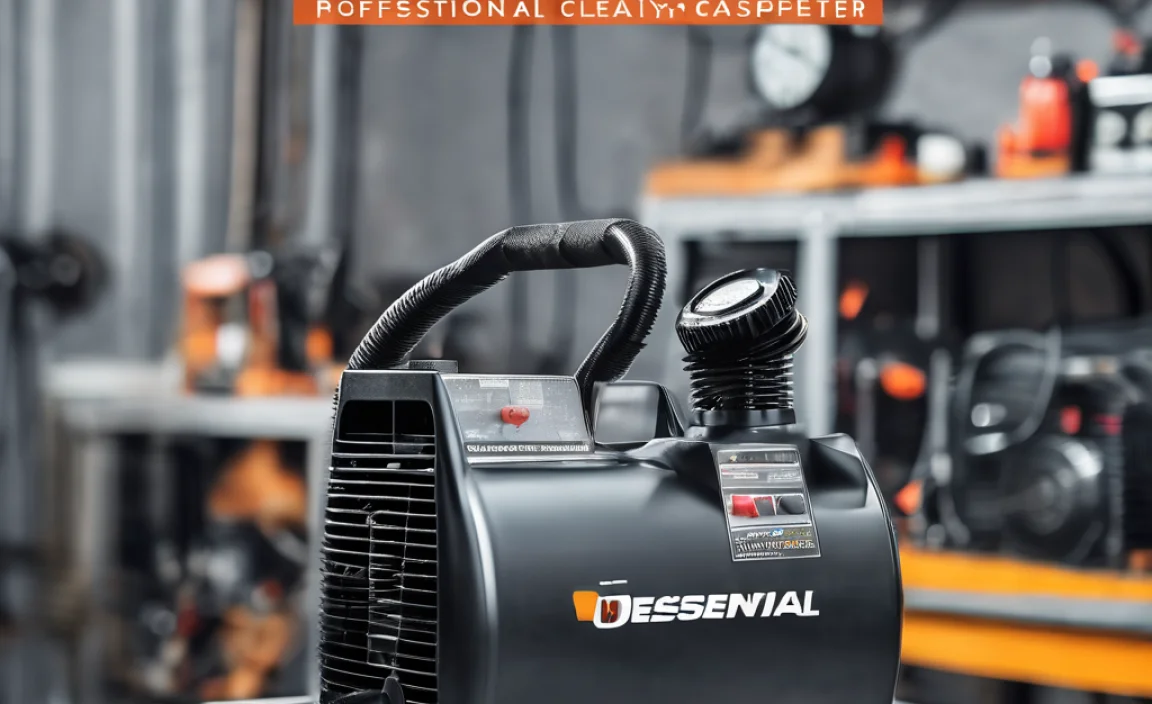
Think of your plasma cutter like an athlete. It needs consistent energy to perform. For a plasma cutter, that energy comes in the form of compressed air. The amount of air your compressor can deliver is measured in Cubic Feet per Minute (CFM). This isn’t just a technical spec; it’s the lifeblood of your cutting operation.
If your air compressor can’t keep up with the plasma cutter’s demand for CFM, you’re going to run into problems. Cuts might be rough, the arc could be unstable, and you might even find yourself cutting out prematurely. That’s why picking the right CFM is super important. You don’t want to buy a compressor that’s underpowered for the job!
Understanding Plasma Cutter Air Requirements
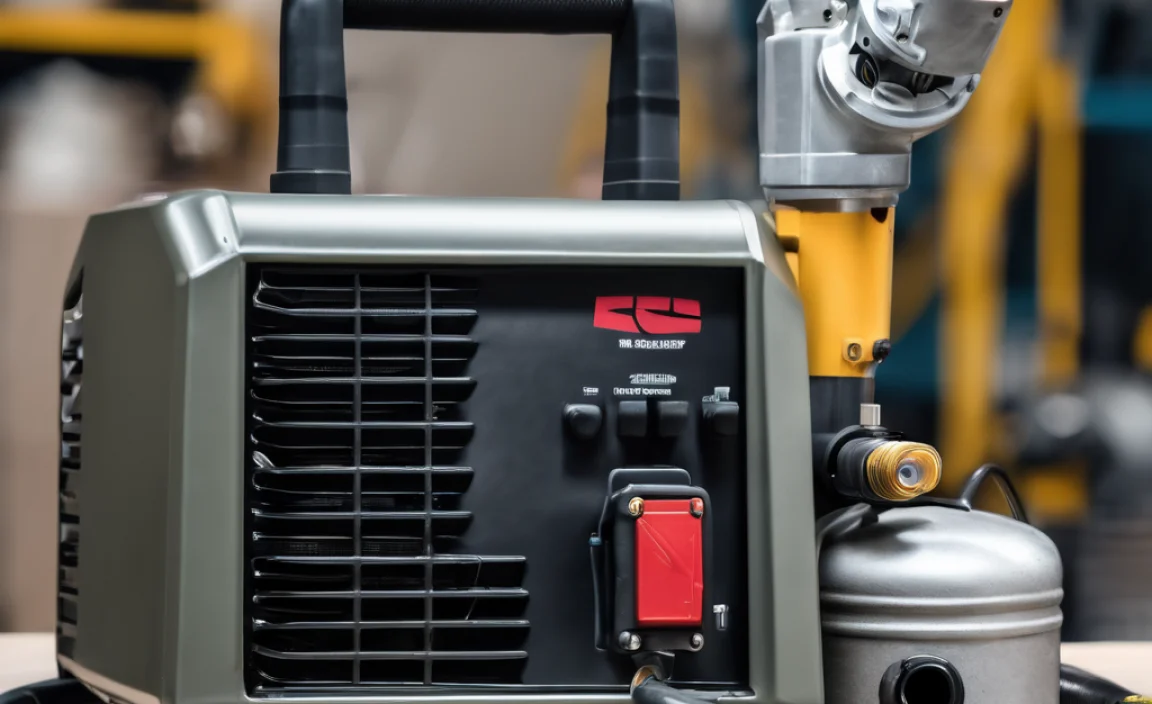
Every plasma cutter has different needs. It’s like how different cars need different types of fuel. You’ll find the specific air requirements listed in your plasma cutter’s manual. Look for two key figures:
- Required CFM: This is the minimum amount of air your plasma cutter needs per minute to operate correctly.
- Required PSI (Pounds per Square Inch): This is the pressure at which the air needs to be delivered.
A good rule of thumb, and something found in many manufacturer guidelines, is to aim for an air compressor that delivers at least 1.5 to 2 times the CFM rating of your plasma cutter at the required PSI. This gives you a buffer, ensuring the compressor isn’t constantly running at its absolute limit. For example, if your plasma cutter needs 5 CFM at 90 PSI, you should look for a compressor that can deliver at least 7.5 to 10 CFM at 90 PSI.
It’s always better to “buy bigger” when choosing an air compressor for plasma cutting. An overpowered compressor struggling to meet demand is way worse than an optimally sized one with a little extra room to breathe.
Key Air Compressor Features to Consider for Plasma Cutting
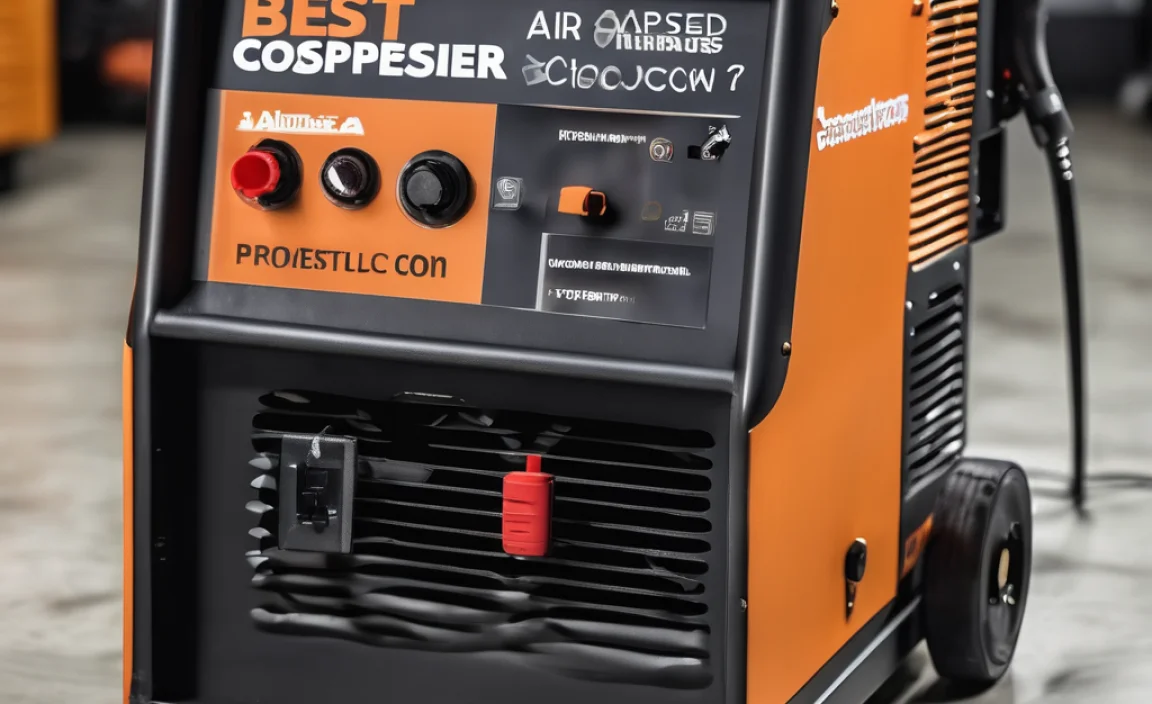
Beyond just CFM and PSI, there are other features that make a big difference when you’re using an air compressor with a plasma cutter. These can impact performance, convenience, and the longevity of both your tools and the compressor itself.
Tank Size Matters (But Not Always How You Think)
The tank is where compressed air is stored. A larger tank size means the compressor can draw in air, compress it, and store it for longer periods before cycling back on. For plasma cutting, a larger tank is beneficial because it:
- Provides a steadier air supply: It can handle short bursts of high air demand from the plasma cutter more smoothly.
- Reduces cycling: The motor won’t turn on and off as frequently, which can extend its lifespan and reduce noise.
While a huge tank isn’t always necessary if your plasma cutter’s draw is consistent and manageable, it’s definitely a helpful feature. Think of it like a reservoir – it keeps a good supply ready when you need it most.
Horsepower (HP): More Power for the Air
Horsepower gives you an idea of the motor’s strength. A higher HP generally means the compressor can deliver more CFM and build pressure faster. For plasma cutting, especially for more demanding jobs or thicker metals, a higher HP motor (often 2 HP or more) is a good bet. It ensures the compressor has the grunt to keep up with your plasma cutter’s appetite for air.
Oil-Lubricated vs. Oil-Free Compressors
This is a big one for air quality and maintenance:
- Oil-Lubricated Compressors: These tend to be more durable, quieter, and better suited for continuous or heavy-duty use. They require regular oil checks and changes. The motor is lubricated by oil, which is great for longevity.
- Oil-Free Compressors: These are generally lighter, require less maintenance (no oil to check!), and are more portable. However, they can be louder and may not last as long under heavy use. They also tend to produce slightly “dirtier” air unless you add filters.
For plasma cutting, where clean, dry air is crucial for optimal performance and to protect the torch, many users prefer oil-lubricated compressors with good filtration systems. However, advanced oil-free models with excellent filters can also do a fine job.
Duty Cycle: How Long Can it Run?
The duty cycle tells you how long a compressor can run within a 10-minute period before needing to cool down. It’s usually expressed as a percentage. For example, a 50% duty cycle means the compressor can run for 5 minutes and then needs to rest for 5 minutes.
Plasma cutting can be demanding. If you anticipate long cutting sessions, you’ll want a compressor with a high duty cycle, ideally 75% or even 100%. This means it’s designed for continuous operation without overheating.
Portability: Will You Move It Much?
Are you working in a dedicated workshop, or do you need to haul your air compressor to different job sites? If portability is key, look for:
- Wheels: Makes it easier to move around.
- Compact design: Less bulk means easier storage and transport.
- Lower weight: Though this often means a smaller tank or less powerful motor.
For plasma cutters, you usually need a compressor that can deliver a good amount of CFM, which often means larger, less portable units. However, there are increasingly capable portable options available.
CFM and PSI: The Sweet Spot for Plasma Cutters
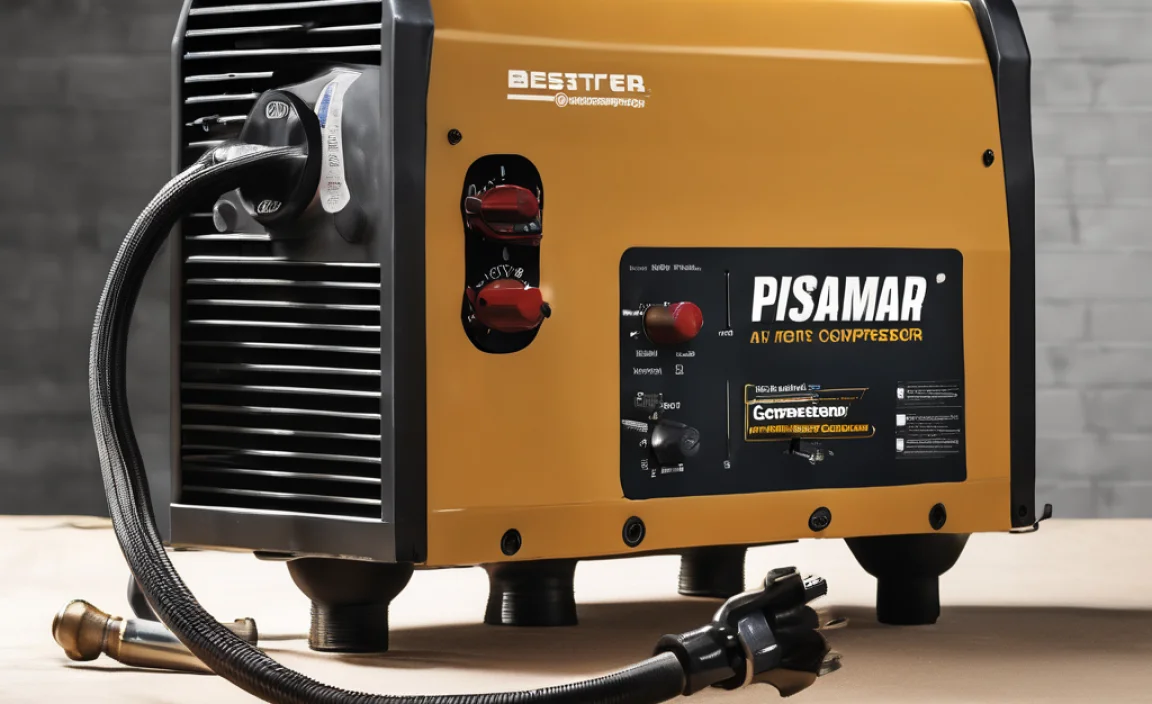
Let’s dive a bit deeper into the numbers, as this is where many beginners get tripped up. It’s all about matching your compressor to your cutter! Remember the rule of thumb: your compressor should reliably deliver 1.5 to 2 times the CFM your plasma cutter requires at the specified PSI.
| Plasma Cutter Use | Approximate CFM Needed @ 90 PSI | Recommended Compressor CFM @ 90 PSI | Suggested HP Range |
|---|---|---|---|
| Light Home/Hobby Use (Thin Metal < 1/4″) | 3-5 CFM | 6-10 CFM | 1.5 – 2 HP |
| Medium Duty (1/4″ – 1/2″ Metal) | 5-8 CFM | 9-15 CFM | 2 – 3 HP |
| Heavy Duty/Professional (1/2″ + Metal) | 8+ CFM | 12-20+ CFM | 3 – 5+ HP |
Quick Note on PSI: Most plasma cutters operate efficiently between 70-100 PSI. Your compressor needs to be able to deliver air at these pressures. Check your plasma cutter’s manual for its specific PSI requirement. Most compressors will list their CFM at 90 PSI, which is a common baseline.
Always prioritize the CFM rating of the compressor at the required PSI of your plasma cutter. A compressor might advertise a high CFM at a low PSI, but if it can’t maintain that flow at the higher PSI your cutter needs, it’s not going to work well.
Top Types of Air Compressors for Plasma Cutting
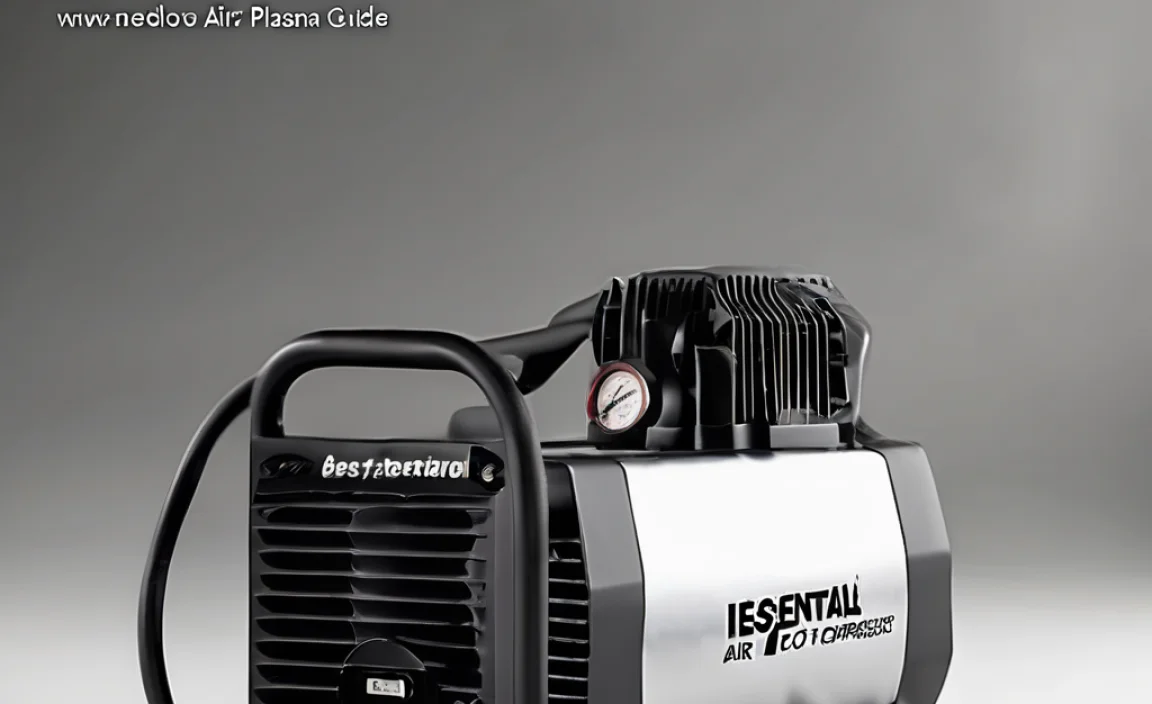
When you’re shopping, you’ll notice a few common types of air compressors. For plasma cutting, piston compressors are generally the go-to.
Reciprocating (Piston) Air Compressors
These are the most common type, using pistons similar to an engine to compress air. They come in various sizes, from small portable units to large industrial machines.
- Single-Stage: Compresses air in one step. Good for lower-pressure applications and less demanding tasks.
- Two-Stage: Compresses air, cools it, and then compresses it again. This results in higher pressure and more efficient operation, making them excellent for plasma cutters that need sustained, higher PSI.
For plasma cutting, a two-stage reciprocating compressor is often recommended for its ability to handle the demands of the process reliably. Many professional workshops opt for these.
Rotary Screw Air Compressors
These are typically found in industrial settings and use rotating screws to compress air. They are very efficient and quiet for their output but are significantly more expensive and generally overkill for a home or small shop plasma cutter. You’re unlikely to need one of these unless you’re running a very high-volume operation.
Essential Accessories for Your Plasma Cutter Air System
Getting the right compressor is only part of the equation. To ensure your plasma cutter runs at its best and that you don’t damage your equipment, consider these accessories:
- Air Filter/Regulator: This is non-negotiable! It removes moisture, oil, and particulates from the compressed air before it reaches your plasma cutter. Moisture and debris can severely damage the torch and lead to poor cuts. An integrated regulator also lets you fine-tune the PSI for optimal performance. Look for units that can handle your compressor’s maximum flow rate.
- Water Separator: Often integrated into the filter/regulator, but standalone units are also available. These are critical for removing condensation.
- Air Dryer (Optional but Recommended for Sensitive Work): For critical applications or if you live in a very humid climate, an air dryer can remove virtually all moisture.
- Hoses and Fittings: Make sure you have high-quality, correctly sized air hoses and fittings that can handle the required PSI. Using undersized or low-quality hoses can restrict airflow and reduce CFM.
Investing in good filtration is like buying insurance for your expensive plasma cutter. It’s well worth the cost!
Putting It All Together: Choosing Your Compressor
Alright, let’s consolidate. To pick the best air compressor for your plasma cutter, follow these simplified steps:
- Check Your Plasma Cutter’s Manual: This is your starting point. Note the required CFM and PSI.
- Calculate Your Needs: Multiply your plasma cutter’s CFM by 1.5 to 2. This gives you your target flow rate.
- Consider Your Workload: Will you be cutting frequently or for long periods? Look for higher HP, larger tanks, and higher duty cycles.
- Decide on Lubrication: Oil-lubricated for durability and quieter operation, oil-free for less maintenance but potentially more noise and shorter lifespan under heavy use.
- Prioritize Filtration: A good air filter/regulator is a must-have accessory.
- Read Reviews: See what other users say about specific models for plasma cutting.
Example Scenario:
Let’s say your trusty new plasma cutter requires 5 CFM at 90 PSI and the manual specifies a maximum of 100 PSI. You plan on doing a fair bit of hobby work, cutting up to 3/8-inch steel. Here’s how you’d choose:
- Target CFM: 5 CFM x 1.5 = 7.5 CFM. So, aim for a compressor that delivers at least 7.5 CFM (preferably 9-10 CFM to be safe) at 90 PSI.
- PSI: Needs to reach at least 90 PSI (and ideally higher, like 120-150 PSI, for reserve capacity).
- HP: A 2 HP to 3 HP motor would be appropriate.
- Tank Size: A 20-30 gallon tank would be a good balance for hobby use, providing enough reserve air without being too cumbersome.
- Type: A two-stage, oil-lubricated reciprocating compressor would be a solid, durable choice for this kind of application.
For the accessory, you’d look for an air filter/regulator rated for at least 10 CFM and capable of handling up to 150 PSI input, with a 1/4″ or 3/8″ NPT connection.
Where to Find Reliable Information
When you’re researching, it’s always smart to check with reputable sources. For understanding airflow and pressure units, the National Institute of Standards and Technology (NIST) offers great information on measurement standards. Tool manufacturers themselves, like ESAB or Miller Electric, often provide detailed specifications and sometimes guides on their equipment’s power requirements.
Popular Air Compressor Brands and What to Look For
When browsing, you’ll see a lot of familiar names. Some of the most trusted brands for air compressors that often have models suitable for plasma cutting include:
- Ingersoll Rand: Known for robust, industrial-grade compressors.
- Quincy Compressor: Another excellent choice for heavy-duty, reliable units.
- Campbell Hausfeld: Offers a wide range of compressors, from homeowner to professional.
- DeVilbiss: Well-regarded for their performance and durability.
- California Air Tools: Often praised for their quieter, oil-free models that still pack a punch.
When looking at specific models within these brands, always go back to the CFM and PSI ratings! A brand name is good, but specs are king for matching your plasma cutter.
Common Pitfalls to Avoid
Don’t let these trip you up:
- Buying too small: The most common mistake! It leads to frustration and poor results.
- Ignoring your plasma cutter’s manual: It has the exact requirements you need to meet.
- Forgetting air filtration: Essential for protecting your plasma cutter and getting clean cuts.
- Using undersized hoses: Can starve your plasma cutter of air.
- Confusing “maximum” CFM with “continuous” CFM: Always look for the rated CFM at 90 PSI.
Frequently Asked Questions (FAQs)
Q1: How much CFM does a plasma cutter usually need?
Most portable and smaller plasma cutters require around 3-5 CFM at 90 PSI. Larger, industrial-grade units can need 8 CFM or even more. Always check your specific model’s manual.
Q2: Should I get an oil-lubricated or oil-free compressor for my plasma cutter?
Oil-lubricated compressors are generally more durable, quieter, and better for heavy use, making them a popular choice for plasma cutting. Oil-free models are lower maintenance and lighter but can be louder and wear out faster with continuous, demanding use.
Q3: What is the most important spec on an air compressor for plasma cutting?
The CFM (Cubic Feet per Minute) rating at the specified PSI (Pounds per Square Inch) is the most critical. Your compressor must meet or exceed your plasma cutter’s air demands to function properly and deliver clean cuts.
Q4: Do I need a large air compressor for a small plasma cutter?
You need a compressor that meets the CFM and PSI requirements of your plasma cutter. While a small plasma cutter might only need 3-5 CFM, you’ll still want a compressor that can reliably deliver that at the correct pressure, often meaning a 1.5-2 HP motor and a tank of around 10-20 gallons, rather than a tiny pancake compressor that might struggle.

I am passionate about home engineering. I specialize in designing, installing, and maintaining heating, ventilation, and air conditioning systems. My goal is to help people stay comfortable in their homes all year long.


